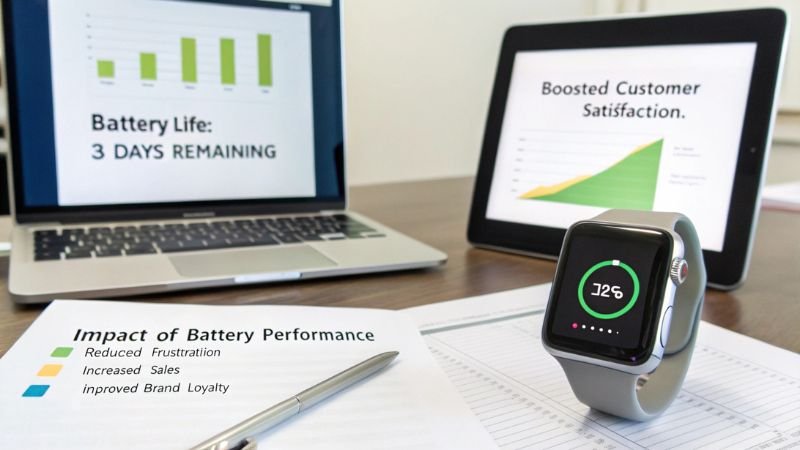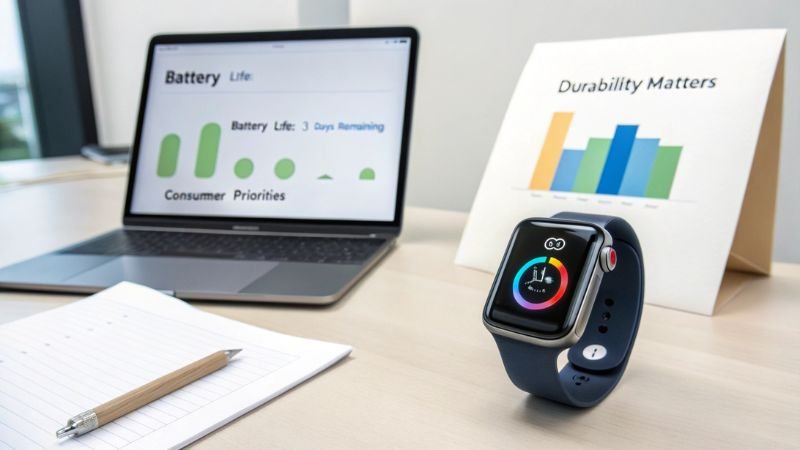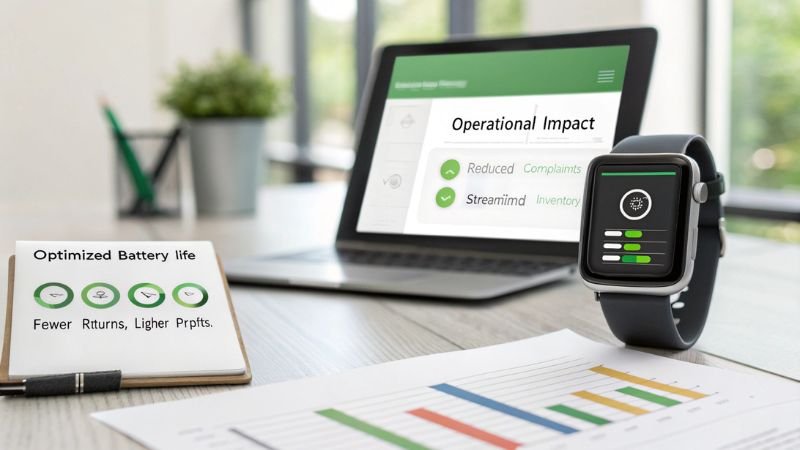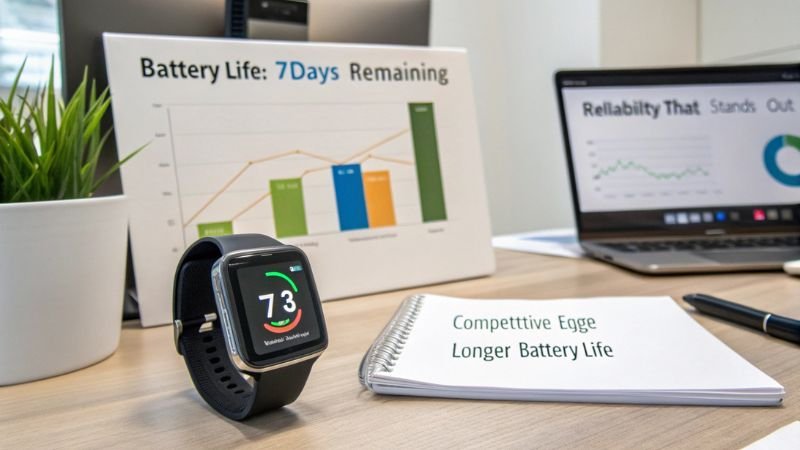How Does Smartwatch Battery Life Impact Customer Experience and Business Performance?

Smartwatch battery life is often seen as just a technical feature, but it has a profound effect on both customer satisfaction and business outcomes. Let’s explore how improving battery performance can enhance your product’s appeal and boost your bottom line.
Smartwatch battery life is critical to customer satisfaction and business performance. A longer-lasting battery reduces frustration, influences buying decisions, and can even improve brand loyalty.
Battery life is one of those features that customers can’t ignore. A smartwatch with poor battery performance can lead to customer frustration, negative reviews, and lost sales opportunities. In contrast, a device that offers long-lasting power can help establish trust, promote repeat business, and set your brand apart. So, how can you optimize battery life to enhance your smartwatch’s success? Let’s dive deeper into the impact of battery life on both customer experience and your bottom line.
How Smartwatch Battery Life Affects Customer Satisfaction and Sales
Smartwatch battery life plays a pivotal role in customer satisfaction. Think about it: customers expect technology that not only works but works reliably throughout the day. If your smartwatch’s battery drains too quickly, it can turn potential buyers into frustrated customers, ultimately hurting your sales.
Battery life directly affects satisfaction. Longer battery life means fewer complaints, positive reviews, and increased sales. A well-performing battery keeps customers happy and loyal.

When a customer purchases a smartwatch, they’re not just buying a piece of tech—they’re buying convenience. A smartwatch that lasts through a whole day or more without needing to recharge becomes a part of the customer’s everyday life. Short battery life, however, can disrupt this experience, making the customer feel like they’re tethered to their charger rather than enjoying the freedom a smartwatch is meant to offer.
For businesses, battery life[^1] issues often translate into returns and negative reviews, especially when customers compare devices. Customers are quick to rate a product poorly if they experience poor battery performance. You can imagine how damaging that could be for a B2B smartwatch brand trying to make a mark in a competitive market.
By investing in better battery optimization1, smartwatch manufacturers can improve the user experience, resulting in a better reputation and greater sales. Offering longer-lasting devices ensures that customers feel they are getting value for their money, which translates to higher satisfaction and higher conversion rates for your business.
Customizing Battery Optimization for OEM and ODM Smartwatch Brands
For OEM (Original Equipment Manufacturers) and ODM (Original Design Manufacturers) smartwatch brands, customizing battery optimization can give a distinct edge in the market. Battery optimization isn’t just about fitting a larger battery; it’s about using the right technology to get the most out of the power available.
Customizing battery optimization can help OEM and ODM smartwatch brands stand out. Smart design, energy-efficient features, and power management can maximize battery life without compromising performance.

As a business, customization is key to differentiating your products in the marketplace. Battery optimization can be tailored to specific market demands by integrating power-efficient technologies, like low-power displays, intelligent power-saving modes2, or even custom chips designed to extend battery life. For OEM and ODM brands, this is an opportunity to build a unique selling point.
By prioritizing battery efficiency in product design, you can extend usage time, which is especially important for industries such as fitness, health monitoring, and outdoor adventures. Customers in these segments demand reliable performance, and a smartwatch that can last through long hikes, workouts, or travel without constantly needing a recharge offers a compelling reason to buy.
These small but meaningful design decisions can make your brand stand out in a crowded market. The end result is a more reliable product that encourages repeat business, elevates brand loyalty, and boosts your company’s reputation in the long run.
The Relationship Between Smartwatch Battery Life and Consumer Buying Decisions
It’s no secret that battery life is one of the main factors influencing a consumer’s decision to buy a smartwatch. But what is it about battery life that makes it such a dealbreaker for potential buyers? Let’s take a closer look.
Battery life heavily impacts buying decisions. Customers tend to avoid watches with poor battery life, opting instead for brands that can promise more durability between charges.

The decision-making process for smartwatch buyers is deeply influenced by battery life. Customers often weigh the tradeoff between features and battery longevity. A product with advanced functions but poor battery life can leave a sour taste in the mouth of buyers who need their devices to last throughout the day.
Interestingly, it’s not just the length of battery life that matters. It’s the overall experience of charging and maintaining the device. A smartwatch that charges quickly and retains its power efficiently creates a smooth user experience that buyers are willing to pay for. Meanwhile, customers who have had poor experiences with unreliable battery performance in the past are likely to opt for a competitor’s model, even if it means paying more.
For businesses, this highlights the importance of considering battery life in product marketing. Clear communication of battery capabilities and optimization can be a deciding factor for potential buyers. Whether through energy-efficient technology3 or clever features like power-saving modes4, showcasing your smartwatch’s battery life as a standout feature can attract more customers and drive sales.
How to Optimize Inventory Management and Profits Through Smartwatch Battery Lifespan
As a smartwatch manufacturer, optimizing battery lifespan isn’t just about keeping your customers happy—it’s also about optimizing your business operations. Efficient battery use can impact your inventory management, supply chain, and even your profit margins.
Efficient battery life management can directly improve your inventory and supply chain by reducing returns, complaints, and wasted resources, ultimately leading to higher profits.

Battery lifespan plays a significant role in inventory management5. Smartwatches with longer-lasting batteries are less likely to suffer from customer returns, as they’ll endure longer without faults or complaints. This leads to fewer units being taken out of circulation and potentially wasted, which can cut down on overall operational costs.
Moreover, ensuring your products are reliable and have a reputation for good battery performance creates better demand forecasting6. When customers know they can rely on your products, repeat orders from businesses become more predictable, and your supply chain operations can run more smoothly.
From a profit perspective, a longer-lasting battery helps extend product life, which not only benefits your customers but also lowers costs in the long run by reducing the need for repairs or replacements. As you reduce the frequency of returns and improve customer satisfaction, your business sees an increase in sales, repeat purchases, and overall profit margins.
How Can Smartwatch Battery Life Influence Brand Loyalty and Repeat Purchases?
A great product will always keep customers coming back—but a smartwatch that doesn’t require constant charging will truly stand out in their memory. Battery life has a major influence on whether customers become repeat buyers, forming the basis for long-term brand loyalty.
Long-lasting battery life leads to better brand loyalty. When customers don’t need to worry about charging, they develop a deeper attachment and trust toward the brand.

Customer loyalty7 is something that takes time to build, but poor battery performance can quickly destroy it. When a customer invests in a smartwatch, they expect it to fit seamlessly into their lives. If the device constantly runs out of power, frustration sets in, and they’re less likely to make a repeat purchase.
However, when your smartwatch performs reliably over time with long-lasting battery life, it creates a sense of trust and satisfaction. Customers are more likely to return for a second purchase, recommend the product to others, and continue their relationship with your brand. The convenience of a device that fits easily into daily routines builds long-term brand affinity8.
For businesses, this can lead to a steady stream of repeat orders, growing brand recognition, and positive word-of-mouth referrals. Essentially, a great battery experience not only makes customers happy in the short term—it creates a lasting bond with your brand.
What Role Does Battery Life Play in Competitive Differentiation for Smartwatch Brands?
In the crowded smartwatch market, differentiation is everything. Brands must look for ways to stand out from the competition, and battery life is a powerful factor that can be leveraged for success.
Battery life is a key differentiator. A longer-lasting battery can set your smartwatch apart from the competition, attracting customers who prioritize reliability and convenience.

In the competitive smartwatch market, the difference between a successful product and one that gets lost in the crowd often comes down to small, yet significant features—like battery life. Many smartwatch brands focus on flashy features or cutting-edge technology, but it’s the simple reliability of a long-lasting battery9 that wins over customers.
Customers may appreciate advanced features like health tracking or customizable interfaces, but if their smartwatch dies in the middle of a workout or meeting, all those features become irrelevant. Battery life, then, becomes a major factor in making a product stand out. By offering a longer-lasting battery that performs consistently, brands can attract customers who value reliability and convenience10, making it a defining factor in their buying decision.
For businesses, this means positioning your smartwatch as the go-to device for customers who want a trustworthy, all-day wearable. Whether you’re marketing to fitness enthusiasts[^1], professionals, or travelers, showcasing superior battery life can help your brand rise above the competition.
Conclusion
Battery life is far more than a technical specification—it’s a powerful tool for boosting customer satisfaction, driving sales, and enhancing brand loyalty. By prioritizing battery optimization, smart brands can differentiate themselves, influence buying decisions, and ultimately improve their bottom line. Whether you’re an OEM, ODM, or retailer, focusing on battery performance will help ensure your smartwatches succeed in an increasingly competitive market.
[^1]: What is the impact of smartwatch battery life on customer satisfaction and sales? – This resource explains how poor battery life in smartwatches can negatively affect customer satisfaction and sales. Understanding this is crucial for businesses to improve their product performance.
-
What is the importance of battery optimization in devices like smartwatches? – Learn about battery optimization techniques that can significantly extend the battery life of smartwatches. Optimizing battery performance is crucial to improve user experience and increase sales. ↩
-
What are low-power displays and intelligent power-saving modes in smartwatches? – Learn more about the technologies behind low-power displays and intelligent power-saving modes, which are critical for extending battery life in smartwatches. ↩
-
How does smartwatch battery life influence consumer buying decisions? – This resource explains how battery life is a key factor in consumer buying decisions. By understanding its influence, brands can better market their products and meet consumer needs. ↩
-
What are power-saving modes and energy-efficient technologies in smartwatches? – Learn about power-saving modes and energy-efficient technologies that contribute to longer battery life and improve the user experience, making a smartwatch more attractive to buyers. ↩
-
How does efficient battery management impact smartwatch inventory and supply chain? – This resource will explain how managing battery lifespan efficiently can reduce returns, improve inventory control, and lead to higher profit margins for smartwatch manufacturers. ↩
-
What are the benefits of reliable demand forecasting in inventory management? – Learn about how reliable demand forecasting, supported by good product performance like battery life, helps streamline supply chains and reduce operational costs. ↩
-
How does battery life contribute to brand loyalty and repeat purchases? – This resource explains how long-lasting battery life influences brand loyalty. By understanding this connection, brands can foster repeat purchases and customer retention. ↩
-
What strategies can businesses use to build brand loyalty in the smartwatch market? – Learn about customer retention strategies, including the role of product reliability, battery performance, and trust-building in developing long-term brand loyalty. ↩
-
How can smartwatch battery life differentiate a brand in a competitive market? – This resource explains how battery life can be a significant differentiator for smartwatch brands, helping them stand out in a crowded market and attract loyal customers. ↩
-
What are the best strategies for smartwatch brands to position themselves in a competitive market? – Learn how smartwatch brands can effectively position themselves as reliable and trustworthy by showcasing superior battery performance, attracting customers who value convenience. ↩


